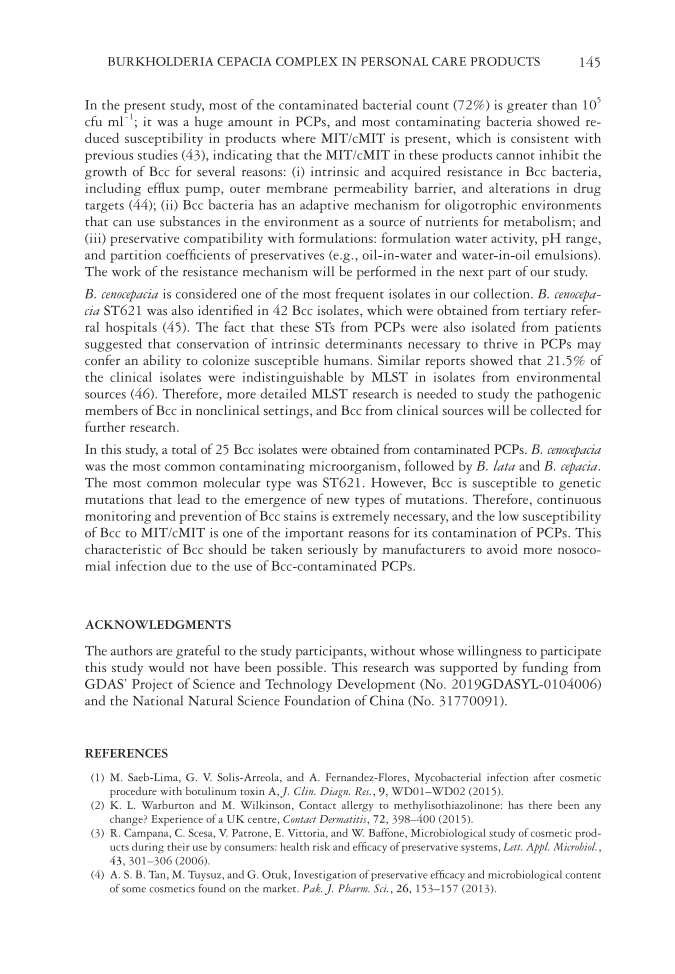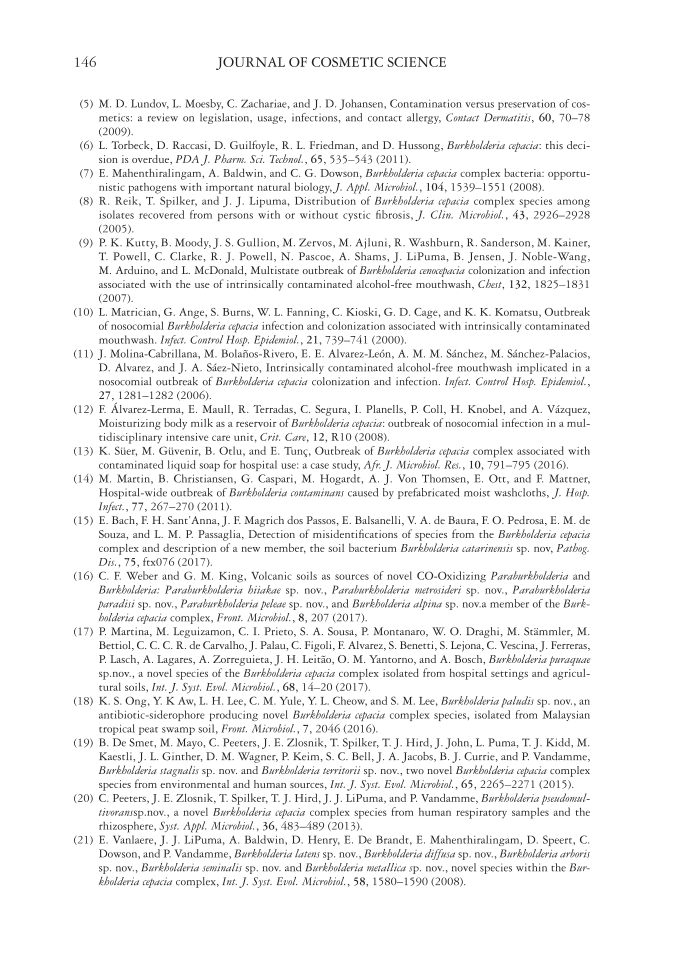BURKHOLDERIA CEPACIA COMPLEX IN PERSONAL CARE PRODUCTS 145 In the present study, most of the contaminated bacterial count (72%) is greater than 105 cfu ml-1 it was a huge amount in PCPs, and most contaminating bacteria showed re- duced susceptibility in products where MIT/cMIT is present, which is consistent with previous studies (43), indicating that the MIT/cMIT in these products cannot inhibit the growth of Bcc for several reasons: (i) intrinsic and acquired resistance in Bcc bacteria, including effl ux pump, outer membrane permeability barrier, and alterations in drug targets (44) (ii) Bcc bacteria has an adaptive mechanism for oligotrophic environments that can use substances in the environment as a source of nutrients for metabolism and (iii) preservative compatibility with formulations: formulation water activity, pH range, and partition coeffi cients of preservatives (e.g., oil-in-water and water-in-oil emulsions). The work of the resistance mechanism will be performed in the next part of our study. B. cenocepacia is considered one of the most frequent isolates in our collection. B. cenocepa- cia ST621 was also identifi ed in 42 Bcc isolates, which were obtained from tertiary refer- ral hospitals (45). The fact that these STs from PCPs were also isolated from patients suggested that conservation of intrinsic determinants necessary to thrive in PCPs may confer an ability to colonize susceptible humans. Similar reports showed that 21.5% of the clinical isolates were indistinguishable by MLST in isolates from environmental sources (46). Therefore, more detailed MLST research is needed to study the pathogenic members of Bcc in nonclinical settings, and Bcc from clinical sources will be collected for further research. In this study, a total of 25 Bcc isolates were obtained from contaminated PCPs. B. cenocepacia was the most common contaminating microorganism, followed by B. lata and B. cepacia. The most common molecular type was ST621. However, Bcc is susceptible to genetic mutations that lead to the emergence of new types of mutations. Therefore, continuous monitoring and prevention of Bcc stains is extremely necessary, and the low susceptibility of Bcc to MIT/cMIT is one of the important reasons for its contamination of PCPs. This characteristic of Bcc should be taken seriously by manufacturers to avoid more nosoco- mial infection due to the use of Bcc-contaminated PCPs. ACKNOWLEDGMENTS The authors are grateful to the study participants, without whose willingness to participate this study would not have been possible. This research was supported by funding from GDAS’ Project of Science and Technology Development (No. 2019GDASYL-0104006) and the National Natural Science Foundation of China (No. 31770091 ). REFERENCES (1) M. Saeb-Lima, G. V. Solis-Arreola, and A. Fernandez-Flores, Mycobacterial infection after cosmetic procedure with botulinum toxin A, J. Clin. Diagn. Res., 9, WD01–WD02 (2015). (2) K. L. Warburton and M. Wilkinson, Contact allergy to methylisothiazolinone: has there been any change? Experience of a UK centre, Contact Dermatitis, 72, 398–400 (2015). (3) R. Campana, C. Scesa, V. Patrone, E. Vittoria, and W. Baffone, Microbiological study of cosmetic prod- ucts during their use by consumers: health risk and effi cacy of preservative systems, Lett. Appl. Microbiol., 43, 301–306 (2006). (4) A. S. B. Tan, M. Tuysuz, and G. Otuk, Investigation of preservative effi cacy and microbiological content of some cosmetics found on the market. Pak. J. Pharm. Sci., 26, 153–157 (2013).
JOURNAL OF COSMETIC SCIENCE 146 (5) M. D. Lundov, L. Moesby, C. Zachariae, and J. D. Johansen, Contamination versus preservation of cos- metics: a review on legislation, usage, infections, and contact allergy, Contact Dermatitis, 60, 70–78 (2009). (6) L. Torbeck, D. Raccasi, D. Guilfoyle, R. L. Friedman, and D. Hussong, Burkholderia cepacia: this deci- sion is overdue, PDA J. Pharm. Sci. Technol., 65, 535–543 (2011). (7) E. Mahenthiralingam, A. Baldwin, and C. G. Dowson, Burkholderia cepacia complex bacteria: opportu- nistic pathogens with important natural biology, J. Appl. Microbiol., 104, 1539–1551 (2008). (8) R. Reik, T. Spilker, and J. J. Lipuma, Distribution of Burkholderia cepacia complex species among isolates recovered from persons with or without cystic fi brosis, J. Clin. Microbiol., 43, 2926–2928 (2005). (9) P. K. Kutty, B. Moody, J. S. Gullion, M. Zervos, M. Ajluni, R. Washburn, R. Sanderson, M. Kainer, T. Powell, C. Clarke, R. J. Powell, N. Pascoe, A. Shams, J. LiPuma, B. Jensen, J. Noble-Wang, M. Arduino, and L. McDonald, Multistate outbreak of Burkholderia cenocepacia colonization and infection associated with the use of intrinsically contaminated alcohol-free mouthwash, Chest, 132, 1825–1831 (2007). (10) L. Matrician, G. Ange, S. Burns, W. L. Fanning, C. Kioski, G. D. Cage, and K. K. Komatsu, Outbreak of nosocomial Burkholderia cepacia infection and colonization associated with intrinsically contaminated mouthwash. Infect. Control Hosp. Epidemiol., 21, 739–741 (2000). (11) J. Molina-Cabrillana, M. Bolaños-Rivero, E. E. Alvarez-León, A. M. M. Sánchez, M. Sánchez-Palacios, D. Alvarez, and J. A. Sáez-Nieto, Intrinsically contaminated alcohol-free mouthwash implicated in a nosocomial outbreak of Burkholderia cepacia colonization and infection. Infect. Control Hosp. Epidemiol., 27, 1281–1282 (2006). (12 ) F. Álvarez-Lerma, E. Maull, R. Terradas, C. Segura, I. Planells, P. Coll, H. Knobel, and A. Vázquez, Moisturizing body milk as a reservoir of Burkholderia cepacia: outbreak of nosocomial infection in a mul- tidisciplinary intensive care unit, Crit. Care, 12, R10 (2008). (13) K . Süer, M. Güvenir, B. Otlu, and E. Tunç, Outbreak of Burkholderia cepacia complex associated with contaminated liquid soap for hospital use: a case study, Afr. J. Microbiol. Res., 10, 791–795 (2016). (14) M. M artin, B. Christiansen, G. Caspari, M. Hogardt, A. J. Von Thomsen, E. Ott, and F. Mattner, Hospital-wide outbreak of Burkholderia contaminans caused by prefabricated moist washcloths, J. Hosp. Infect., 77, 267–270 (2011). (15) E. B ach, F. H. Sant’Anna, J. F. Magrich dos Passos, E. Balsanelli, V. A. de Baura, F. O. Pedrosa, E. M. de Souza, and L. M. P. Passaglia, Detection of misidentifi cations of species from the Burkholderia cepacia complex and description of a new member, the soil bacterium Burkholderia catarinensis sp. nov, Pathog. Dis., 75, ftx076 (2017). (16) C. F . Weber and G. M. King, Volcanic soils as sources of novel CO-Oxidizing Paraburkholderia and Burkholderia: Paraburkholderia hiiakae sp. nov., Paraburkholderia metrosideri sp. nov., Paraburkholderia paradisi sp. nov., Paraburkholderia peleae sp. nov., and Burkholderia alpina sp. nov.a member of the Burk- holderia cepacia complex, Front. Microbiol., 8, 207 (2017). (17) P. M artina, M. Leguizamon, C. I. Prieto, S. A. Sousa, P. Montanaro, W. O. Draghi, M. Stämmler, M. Bettiol, C. C. C. R. de Carvalho, J. Palau, C. Figoli, F. Alvarez, S. Benetti, S. Lejona, C. Vescina, J. Ferreras, P. Lasch, A. Lagares, A. Zorreguieta, J. H. Leitão, O. M. Yantorno, and A. Bosch, Burkholderia puraquae sp.nov., a novel species of the Burkholderia cepacia complex isolated from hospital settings and agricul- tural soils, Int. J. Syst. Evol. Microbiol., 68, 14–20 (2017). (18) K. S. Ong, Y. K Aw, L. H. Lee, C. M. Yule, Y. L. Cheow, and S. M. Lee, Burkholderia paludis sp. nov., an antibiotic-siderophore producing novel Burkholderia cepacia complex species, isolated from Malaysian tropical peat swamp soil, Front. Microbiol., 7, 2046 (2016). (19) B. De Smet, M. Mayo, C. Peeters, J. E. Zlosnik, T. Spilker, T. J. Hird, J. John, L. Puma, T. J. Kidd, M. Kaestli, J. L. Ginther, D. M. Wagner, P. Keim, S. C. Bell, J. A. Jacobs, B. J. Currie, and P. Vandamme, Burkholderia stagnalis sp. nov. and Burkholderia territorii sp. nov., two novel Burkholderia cepacia complex species from environmental and human sources, Int. J. Syst. Evol. Microbiol., 65, 2265–2271 (2015). (20) C. Pe e ters, J. E. Zlosnik, T. Spilker, T. J. Hird, J. J. LiPuma, and P. Vandamme, Burkholderia pseudomul- tivoranssp.nov., a novel Burkholderia cepacia complex species from human respiratory samples and the rhizosphere, Syst. Appl. Microbiol., 36, 483–489 (2013). (21) E. Va n laere, J. J. LiPuma, A. Baldwin, D. Henry, E. De Brandt, E. Mahenthiralingam, D. Speert, C. Dowson, and P. Vandamme, Burkholderia latens sp. nov., Burkholderia diffusa sp. nov., Burkholderia arboris sp. nov., Burkholderia seminalis sp. nov. and Burkholderia metallica sp. nov., novel species within the Bur- kholderia cepacia complex, Int. J. Syst. Evol. Microbiol., 58, 1580–1590 (2008).
Purchased for the exclusive use of nofirst nolast (unknown) From: SCC Media Library & Resource Center (library.scconline.org)











































































